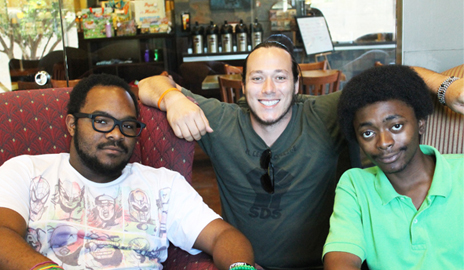LGBT rights are now a central issue for the anti-Vietnam War group revived in 2006
DAVID TAFFET | Staff Writer
taffet@dallasvoice.com
Students at El Centro College and UT Arlington have organized new chapters of Students for a Democratic Society, and the group has popped up on as many as 90 college campuses around the country.
The reincarnation of SDS, a major force in the antiwar movement during the Vietnam era, began in 2006.
At the Equality March for LGBT rights held in Downtown Dallas on June 25, members of SDS marched for gay rights and spoke at the rally at the JFK Memorial. All of the SDS members participating were straight.
Brashad Lewis does public relations for the local groups and plans to start a group on a Tarrant County College campus that he’ll attend in the fall.
He said the group hopes to bring the national convention of SDS chapters to Dallas or Arlington in October. They’ve submitted their bids and will hear back soon.
But organizers say that should the Dallas bid win, one minor obstacle stands in the way: The El Centro group is currently without a faculty advisor.
Stephen Benavides, a graduate student at UTA, said that he was at El Centro and a Dallas County Community College officer motioned for him to come over and then assaulted him with a police baton.
Benavides said that a complaint has been filed.
Then four days later, the faculty advisor to the group abruptly quit.
Deante Toombs, an El Centro student, said that to reserve rooms for the conference, the group needs to be recognized, but finding another faculty advisor should be no problem.
Benavides said that the advisor at UTA is a former SDS member from the ’60s with tenure and has no fear of reprisals.
But he said that the incident at El Centro shows that the group is being followed and members being targeted despite the peaceful history of SDS.
In another incident, SDS organized a protest of cuts to teaching staff and financial aid and increased class size. Protesters planned to meet at Rosa Parks Plaza near El Centro. Rather than the peaceful demonstration planned, marchers were met with DART police on bicycles blocking entrance to the square. Marchers used streets and sidewalks instead and paraded on downtown streets to protest the cuts.
Toombs said that LGBT equality is a central issue for SDS.
“SDS stands in solidarity with issues affecting minorities, gays, women,” Toombs said.
“It’s 2011,” Benavides said. “Are we still having problems with this now?”
He said that’s why the group participated in the Equality March and may march in the Alan Ross Texas Freedom Parade.
Toombs said that the group is being targeted differently than it was in the ’60s. Then the FBI infiltrated with agitators to get information while trying to break the groups up through dissention.
Today, they’re being threatened with prosecution under the Patriot Act as if they’re a terrorist threat.
In addition to local campus issues, the original SDS organized nationally to protest the Vietnam War. Benavides said that local issues — LGBT rights, cuts in school funding — are important to SDS groups across the country, but the wars in Iraq, Afghanistan and now Libya are why they came together.
Lewis said the attacks from campus police, reportedly instigated by federal authorities that want SDS disbanded, are using the divide and conquer method.
Toombs said that the group at El Centro has protested peacefully and exercised its right of free speech.
What has surprised him is the power the name still holds 40 years after the original group officially folded.
SDS is the model for all types of student groups based on causes that followed over succeeding decades — women’s rights, LGBT rights, AIDS, civil rights, environmental issues. These groups worked on a shoestring budget and used direct action to demand certain results. Without Facebook or the Internet to interact, SDS held annual national conventions to meet each other and exchange ideas.
At a convention in 1969, SDS officially ended, but a number of local campus groups lasted into the early to mid ’70s to continue protesting the war and to work on local campus issues.
Best known among early SDS organizers was Tom Hayden. Hayden later went on to serve in the California Legislature and ran for governor and mayor of Los Angeles and was a U.S. senator. But he is still best known as the first husband of Jane Fonda. At the time, Fonda was known more for her antiwar activism rather than her acting.
Bernadette Dohrn, another well-known SDS member, founded the radical wing known as the Weather Underground with her husband Bill Ayers. Dohrn is now an associate professor of law at Northwestern University School of Law, but during the early ’70s, she was on the FBI’s Ten Most Wanted list.
Still, most of the actions of the group were peaceful. They staged draft-card burnings to protest the war. They did sit-ins to take over campus administration buildings. They marched and rallied.
Benavides said that if they took over a campus building today, they’d send in the SWAT team.
But Benavides, Toombs and Lewis have fashioned their campus groups on the model of the peaceful wing of the group.
“Education is a right,” Benavides said.
Toombs said that discrimination can’t be tolerated.
But none proposed any violent action to achieve their goals.
On July 27, SDS is sponsoring a conference on Islamophobia and the New McCarthyism at UTA. They’re working on a women’s conference in August and hope to host the national convention in October. David Taffet, who wrote this article, was a member of SDS at SUNY Albany in the early 1970s.















Hey who’s down to help organize this Gender equality Conference in August?